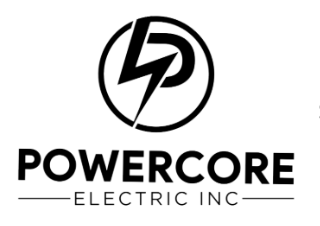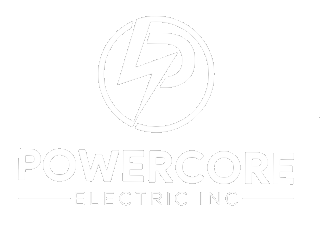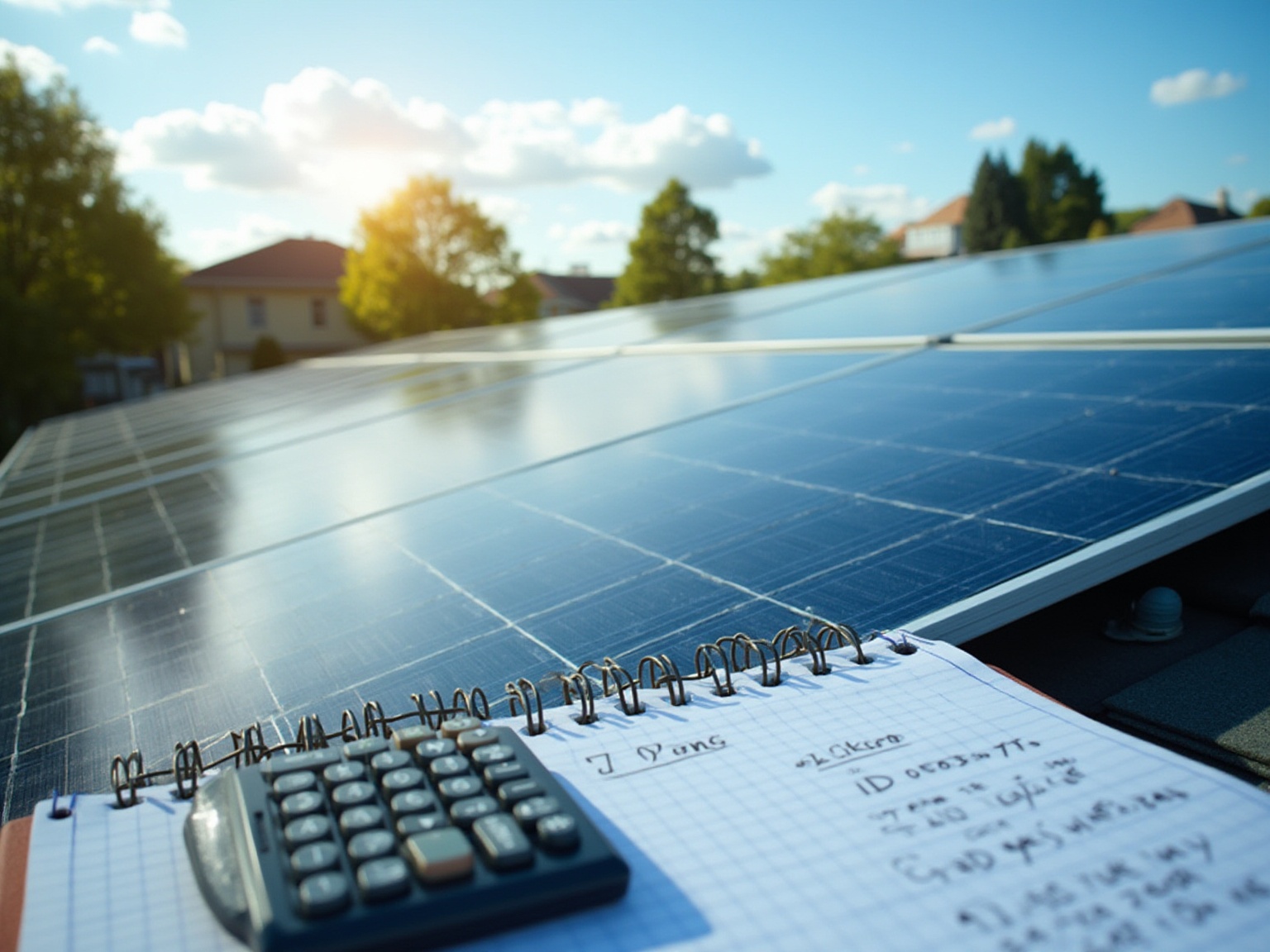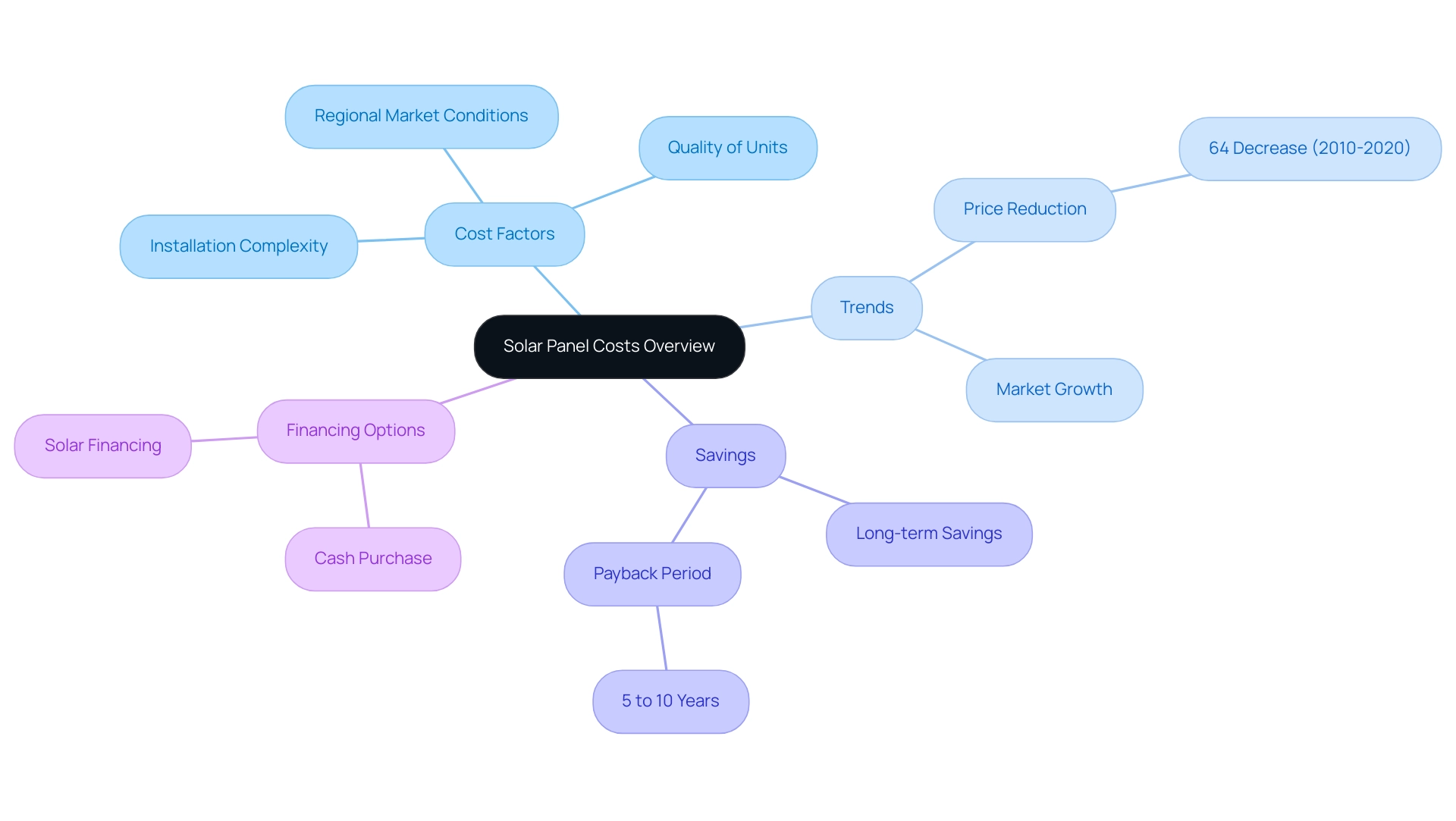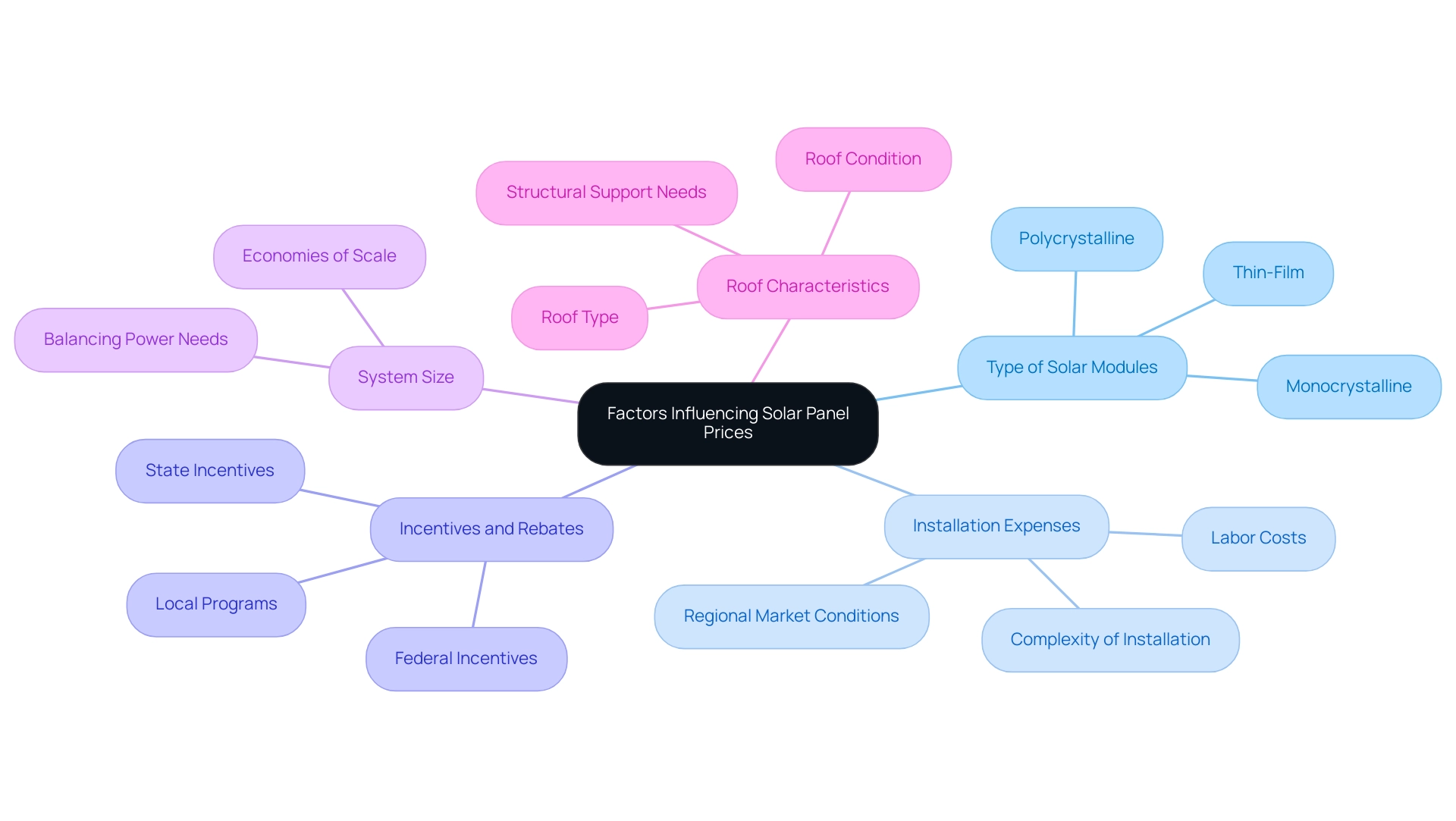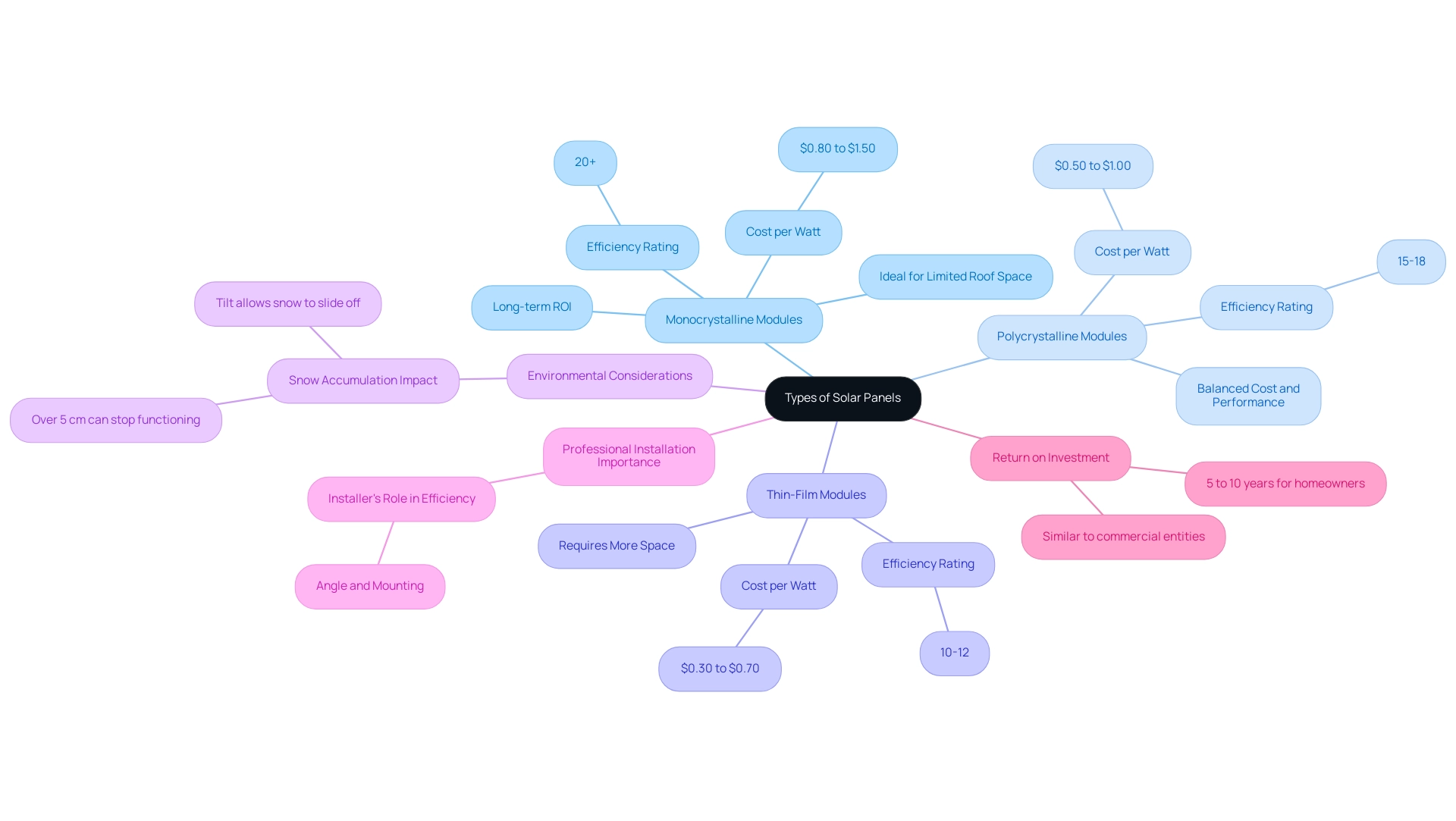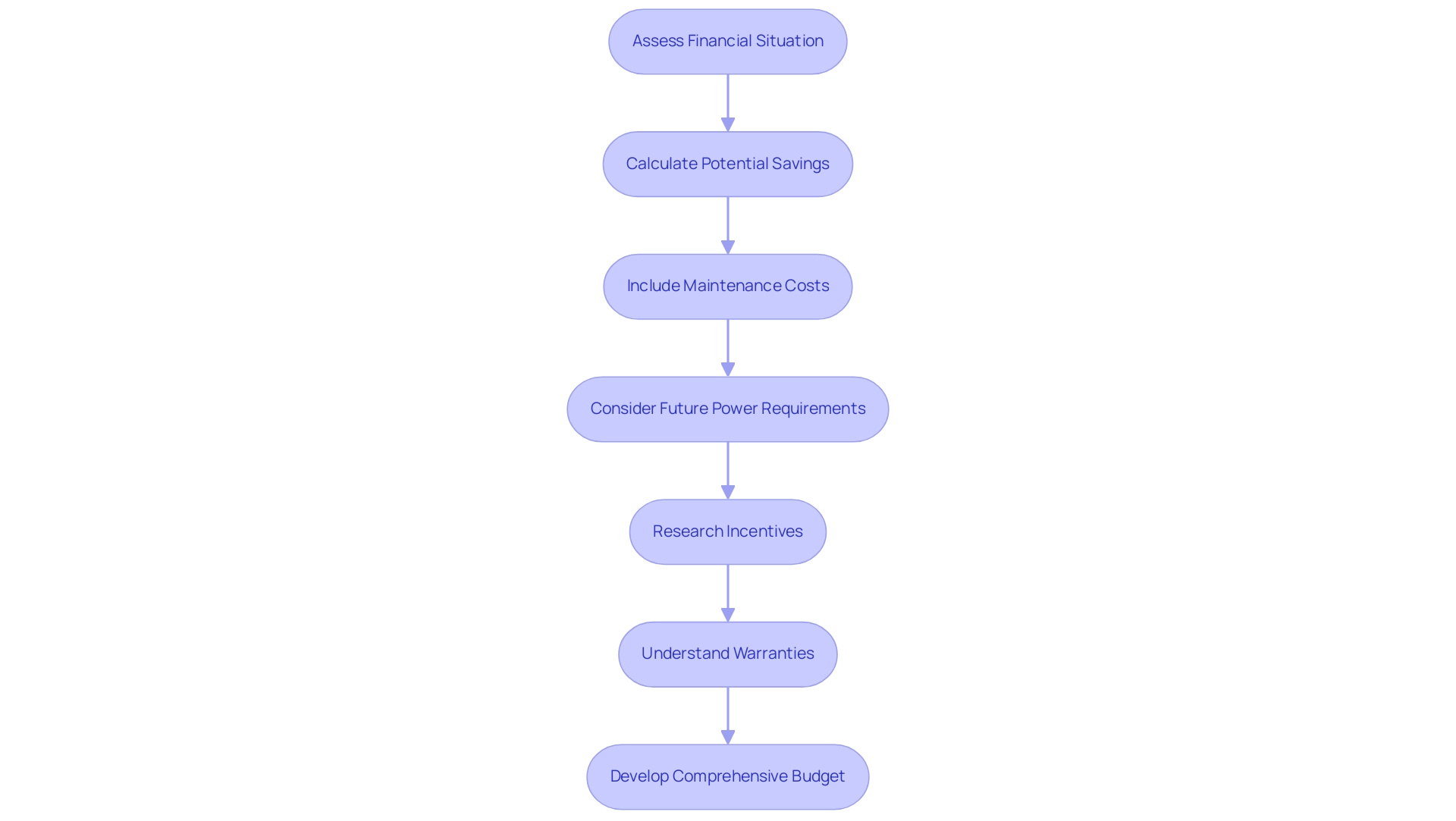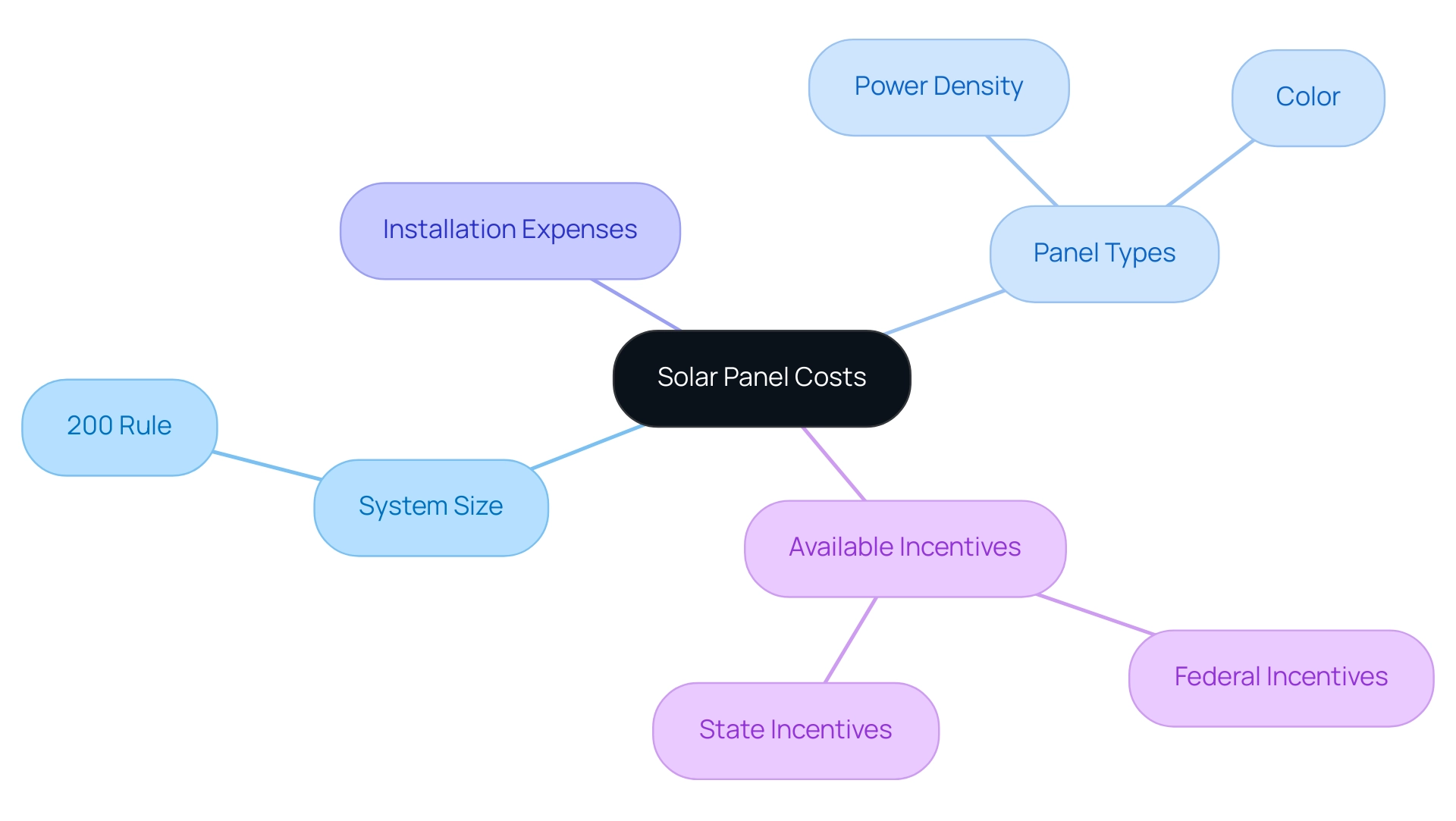Overview
We understand that the cost of solar panels for residential systems can be a significant concern for homeowners, typically ranging from $13,549 to $25,974. This variation is influenced by factors such as:
- System size
- Panel type
- Installation complexity
- Available federal and state incentives
By understanding these costs and leveraging available incentives, you can significantly enhance affordability. This not only encourages you to invest in renewable energy but also leads to long-term savings on your electricity bills. Together, we can explore how solar energy can provide you with the independence and peace of mind you deserve.
Introduction
In 2025, we understand that the solar panel market presents an evolving landscape, where costs are influenced by a myriad of factors, from panel types to installation complexities and regional dynamics. Many homeowners are increasingly drawn to solar energy, not only for its potential to lower electricity bills but also for its empowering role in promoting energy independence.
With average expenditures for residential solar systems ranging from approximately $13,549 to $25,974—after accounting for federal tax credits—it’s crucial to grasp the nuances of pricing and installation. This guide delves into key aspects of solar panel costs, highlighting trends that favor states like California, where abundant sunshine and high utility rates create an ideal environment for solar investments.
As you navigate this transition, understanding the financial implications and available incentives can truly empower you to make informed decisions that align with your energy needs and sustainability goals. Together, we can explore the possibilities that solar energy offers for a brighter, more independent future.
Understanding Solar Panel Costs: An Overview
In 2025, many homeowners are understandably concerned about rising energy costs. The landscape of energy collector costs reflects a dynamic market influenced by various factors, including type, installation complexity, and regional market conditions. If you’re wondering how much solar panels cost, you can expect an average investment between $13,549 and $25,974 for a residential panel system, especially when considering federal tax credits. This investment not only helps in lowering electricity costs but also encourages power independence, making it an attractive choice for many families seeking relief from high utility bills.
It’s common to feel overwhelmed by energy expenses, but current trends indicate that California remains one of the most favorable states for savings from renewable sources. Thanks to its abundant sunshine and elevated utility rates, homeowners are progressively opting for renewable power options to alleviate escalating expenses. While the typical expense of residential photovoltaic installations in 2025 has experienced variations, the general direction indicates a persistent reduction in prices, rendering this energy source more attainable than ever.
Significantly, the expense of residential photovoltaic systems decreased an impressive 64 percent from 2010 to 2020, according to the National Renewable Energy Laboratory, highlighting the increasing affordability of photovoltaic technology. This trend is encouraging for those considering a shift to solar energy.
At Powercore Electric, we understand that navigating these advantageous circumstances for energy savings can be daunting. As a locally owned and community-oriented company, we play an essential role in assisting California homeowners. Our expert assessments emphasize several important pricing elements that affect the expenses of photovoltaic modules, including the quality of the units, the intricacy of the installation procedure, and regional market dynamics. For instance, a compact solar setup equipped with 10 kWh of battery storage can supply essential home systems for up to three days, demonstrating the importance of investing in power storage along with solar devices, especially in maintaining reliability during outages.
When evaluating solar power expenses against conventional electricity bills, many homeowners frequently discover that the long-term savings from these systems can greatly surpass the initial expenditure. Case studies demonstrate that the payback period for photovoltaic systems generally varies from 5 to 10 years, based on personal utility rates, electricity usage, and financing alternatives. Homeowners who choose solar financing can enjoy prompt savings, while those who make cash purchases frequently enhance their long-term savings prospects.
In summary, understanding how much solar panels cost and the current installation charges in California is essential for homeowners seeking to invest in renewable power. By breaking down these costs and examining real-world examples, we aim to empower you to make informed decisions about your renewable energy investment. Together, we can work towards a more sustainable future.
Key Factors Influencing Solar Panel Prices
Are you feeling overwhelmed by rising energy bills? You’re not alone. Many homeowners share your concerns, and the good news is that solar energy offers a sustainable solution that can lead to energy independence and significant savings.
Several key factors significantly influence the pricing of solar panels, which are essential for homeowners considering this transition:
- Type of Solar Modules: The market provides various kinds of solar modules, including monocrystalline, polycrystalline, and thin-film options. Monocrystalline panels, although usually pricier, offer greater efficiency and improved performance in confined areas. This makes them a favored option for homeowners pursuing maximum power output and long-term sustainability. By choosing the right type, you can save money while embracing energy independence.
- Installation Expenses: We understand that labor expenses are a crucial element of the total installation price and can vary significantly depending on the complexity of the installation and regional market conditions. In California, for example, the average labor expense for panel installation in 2025 reflects the state’s competitive environment, where skilled workers are in high demand. This can lead to increased overall installation prices, particularly for more intricate setups. However, California also has the lowest average expense of renewable energy installations compared to other states, which can be beneficial for you as you aim to lower utility expenses and improve energy autonomy.
- Incentives and Rebates: It’s common to feel uncertain about the costs involved, but homeowners can take advantage of federal and state incentives, which can significantly reduce the initial expenses of renewable energy systems. Comprehending the available incentives is essential for precise estimation, as local programs may provide rebates based on system size, with larger installations frequently qualifying for greater incentives. This financial assistance encourages sustainability and makes renewable energy more accessible, allowing you to kickstart your sustainability journey.
- System Size: The dimensions of your solar system play a pivotal role in determining expenses. Larger systems typically benefit from economies of scale, resulting in a lower cost per watt. However, the total upfront investment will be higher, making it essential for you to balance your power needs with budget considerations. This balance is crucial for achieving energy stability and independence.
- Roof Characteristics: The type and condition of your roof can greatly influence installation expenses. Roofs that need extra structural support or possess intricate designs may involve higher expenses due to the additional labor and materials required. For example, a roof with multiple angles or a steep pitch may necessitate specialized installation techniques, further influencing the overall price.
By considering these factors, you can better navigate the complexities of solar panel costs and make informed decisions that align with your power objectives and financial capabilities. Applying expense reduction tactics, such as exploring financing alternatives or acquiring several estimates, can also improve affordability, allowing more homeowners to adopt clean power solutions. As highlighted in the case study ‘Cost Reduction Strategies for Solar,’ you can lower your upfront costs for renewable energy by financing your systems, installing smaller units, choosing less expensive equipment, or obtaining multiple quotes.
Additionally, Powercore Electric’s in-house team of experts ensures high-quality installations and maintenance, providing the support needed to navigate these pricing factors effectively. Together, let’s discover ways to conserve funds and adopt self-sufficiency through renewable sources. Obtain your complimentary personalized estimate today. According to Catherine Lane, Written Content Manager at SolarReviews, understanding these elements is crucial for homeowners like you looking to invest in renewable energy.
The Impact of System Size on Solar Panel Costs
The scale of your energy panel system is vital in determining the cost of solar panels and their overall efficiency as an investment. We understand that navigating these choices can feel overwhelming. Typically, larger systems offer a lower price per watt, making them more economical in the long run. For instance, in California, when considering how much solar panels cost, a 5 kW energy system may range from $9,854 to $13,332, while a 10 kW system can be priced between $20,000 and $30,000.
This price difference highlights the importance of assessing solar panel costs in relation to your power needs before making a decision. California boasts the lowest average installation costs in the United States, underscoring the economic benefits of investing in renewable sources in this region. When determining the right system size, it’s essential for homeowners to evaluate their average power usage. In 2025, the average California household consumes approximately 600 kWh per month.
By understanding your monthly electricity consumption and the typical power generation in your area, you can more effectively evaluate the system size that will optimize your savings. Furthermore, the Department of Energy’s SolarApp+ initiative aims to simplify the interconnection process for photovoltaic systems, making it easier for homeowners to transition to renewable power. This initiative is crucial because a well-sized solar system not only enhances your energy independence but also ensures that your investment yields significant returns over time.
Consider how much solar panels cost based on system size:
- A 5 kW system may be adequate for smaller households or those with lower power needs.
- Larger families or homes with higher energy consumption may benefit from a 10 kW system.
This strategic sizing can lead to substantial savings on energy bills and a quicker return on investment. As Andy Schell notes, “Each panel system is uniquely designed to suit its location and the needs of its owner,” emphasizing the importance of customizing energy solutions to fit individual circumstances.
Additionally, exploring DIY energy installations can be an option for those looking to save on labor costs. While DIY projects can reduce expenses, they also introduce complexity and safety risks, potentially voiding warranties. Therefore, it’s essential to carefully weigh the pros and cons before embarking on such a project. For instance, while DIY installations can lower costs, the potential for errors and the associated risks require thoughtful consideration.
In summary, understanding the relationship between system size and costs is crucial for homeowners seeking to utilize renewable power efficiently. By aligning your system size with your energy usage, you can ensure a sustainable and economical solution, maximizing the benefits of photovoltaic resources while adhering to best practices for selecting inverter systems and battery options. Together, we can navigate this journey towards energy independence. For more detailed insights, consider referring to user manuals and case studies provided by Powercore Electric, which can offer valuable guidance on optimizing your renewable power investment.
Types of Solar Panels and Their Cost Implications
When exploring solar energy options, we understand that homeowners often face concerns about rising energy bills. You will encounter three primary types of solar panels, each with distinct characteristics and cost implications that can help you take control of your energy future:
- Monocrystalline Modules: Renowned for their high efficiency and modern aesthetic, monocrystalline modules stand out as a premium choice among solar options. Their expenses typically range from $0.80 to $1.50 per watt. Designed to maximize energy output, these modules are ideal for homeowners with limited roof space who wish to achieve the highest possible energy production. Investing in monocrystalline systems can provide a superior long-term return on investment, despite the higher initial expenses. Moreover, their efficiency ratings have progressed, with many attaining over 20% in 2025, highlighting their importance in fostering sustainability and lowering utility expenses.
- Polycrystalline Modules: If you are looking for a more economical option, polycrystalline modules usually range from $0.50 to $1.00 per watt. While they are somewhat less efficient than their monocrystalline counterparts, they strike a favorable balance between cost and performance, making them a popular choice for many homeowners looking to invest in solar power without breaking the bank. The efficiency ratings for polycrystalline modules typically range from 15% to 18%, offering a solid choice for those looking to improve their power independence.
- Thin-Film Modules: As the most economical option, thin-film modules are priced around $0.30 to $0.70 per watt. However, they come with trade-offs in efficiency, requiring more space for installation due to their reduced power output. It’s important to thoughtfully evaluate your available installation space and power requirements when considering thin-film technology, as these units typically attain efficiency ratings of about 10% to 12%. While they may be less efficient, they can still contribute to your overall sustainability goals.
In 2025, homeowners can anticipate a return on investment within five to ten years, akin to commercial entities, emphasizing the financial advantages of renewable energy investments. Moreover, the rising trend of government incentives for renewable energy adoption, as observed in different areas, highlights the increasing backing for photovoltaic energy, making it a timely investment for eco-conscious homeowners.
Furthermore, it’s crucial to take into account environmental elements like snow accumulation, which can influence the performance of photovoltaic systems. Snow buildup exceeding 5 cm can prevent photovoltaic systems from functioning, but their angle permits snow to slide off, and they can still produce electricity in snowy conditions.
A quote from Tom Beresnyak, a Pennsylvania State University Extension Educator, emphasizes the importance of professional installation: “The installer can make a huge difference because the angle and the mount [are important for] maximizing what you have at that location — a skilled installer is still going to be the real key in your long-term production.”
Moreover, integrating battery backups is crucial for ensuring reliable energy during power outages and adverse weather conditions, enhancing energy independence for homeowners like you.
Ultimately, understanding the cost of solar panels, along with their cost per watt and efficiency ratings, is crucial for making an informed decision. As the solar market continues to grow, we encourage you to evaluate your unique circumstances and consult with experienced installers to determine the best solar solution for your needs. To kickstart your journey towards sustainability and autonomy, get your free, personalized estimate today.
This comprehensive approach not only enhances efficiency but also aligns with the broader goals of sustainability and independence from traditional power sources.
Calculating Savings: Return on Investment for Solar Panels
Determining the return on investment (ROI) for photovoltaic systems can feel overwhelming, but with a methodical strategy, homeowners can make informed choices about their energy investments. Here’s a step-by-step guide to help you navigate this journey:
-
Determine Total Expenses: Start by calculating your total expenses. This includes not only the installation fees but also the cost of the solar panels and any additional expenses such as permits or inspections. Understanding these costs is crucial as it lays the foundation for your investment.
-
Estimate Annual Savings: Next, think about how much you will save on your electricity bills each year. For example, if your monthly electricity bill is $150, your annual savings could amount to approximately $1,800. This figure may vary based on your energy consumption and local electricity rates, but it’s a significant consideration for your financial planning.
-
Calculate Payback Period: To understand how long it will take to recover your investment, divide your total expenses by your annual savings. For instance, if your total investment is $20,000 and you save $1,800 each year, your payback period would be around 11 years. This metric is essential for grasping the long-term advantages of your energy investment, offering peace of mind as you look ahead.
-
Consider Incentives: Don’t overlook any available incentives that can lower your initial investment. For example, the federal renewable energy tax credit allows you to deduct 30% of your installation expenses from your federal taxes. As Emily Walker notes, “The higher the price tag, though, the more you’ll get back as a credit towards your federal tax bill.” Additionally, local incentives and rebates in Bakersfield, such as the California Solar Initiative, can further promote renewable energy adoption, enhancing your overall savings and improving your ROI.
-
Evaluate Long-Term Benefits: Homes equipped with photovoltaic systems can sell for approximately 4.1% more than comparable homes without such systems, adding to the financial advantages of your investment. Furthermore, considering California’s unique climate and regulatory environment is essential; homeowners should ensure their energy systems are compliant with local building codes and community guidelines to maximize efficiency and effectiveness. This is especially significant given the varied climate and stringent regulations in California, as highlighted in case studies on renewable considerations, which show that homes with photovoltaic systems often enjoy enhanced property values and reduced utility expenses.
-
Compare Quotes: Ultimately, comparing estimates from various installers is vital for ensuring fair pricing and making informed decisions. This step can help you find the best value for your investment, ensuring you feel confident in your choice.
By following these steps, homeowners can effectively assess how much the solar panels truly cost in terms of their ROI for photovoltaic systems, leading to a well-informed decision that aligns with their financial objectives and commitment to sustainable energy practices. At Powercore Electric, we understand the importance of community focus and personalized service. We are here to assist homeowners in navigating these considerations, ensuring you understand the functionality of photovoltaic modules and the best practices for selecting inverter systems. Together, we can work towards a brighter, more sustainable future.
Leveraging Incentives: How to Reduce Your Solar Panel Costs
As a property owner, you may be feeling the weight of rising energy costs. It’s common to wonder how you can manage these expenses while also making a positive impact on the environment. Fortunately, there are a range of incentives available in 2025 that can significantly lower the expense of energy installations, making the transition to renewable energy not just a dream, but an achievable reality.
- Federal Solar Tax Credit: Currently, homeowners can claim a substantial 30% tax credit on the installation costs of photovoltaic panels. This incentive effectively reduces your initial investment, making renewable power more accessible and financially appealing compared to conventional electricity. You might be asking yourself, how much are the solar panels, and this incentive could make that question easier to answer.
- State Incentives: In California, various state-specific rebates and tax credits for photovoltaic installations can further decrease your expenses. We understand that navigating these options can be overwhelming, so we encourage you to contact your state’s resource office to discover available programs that can enhance your overall savings related to renewable power.
- Local Utility Programs: Many utility providers in California offer incentives for photovoltaic installations, including rebates or performance-based rewards. These programs can help reduce your installation expenses and improve your return on investment, making renewable resources a more viable choice for environmentally conscious homeowners like you.
- Financing Options: Exploring financing options such as energy loans or leases can make the initial investment more manageable. These choices allow you to spread the cost over time, facilitating a smoother transition to renewable power and making it easier to incorporate EV charging solutions into your home.
- Expert Insights: Industry experts emphasize the importance of understanding and utilizing these incentives. For instance, Ben Zientara, a policy analyst in renewable energy, noted that evolving federal policies could significantly impact installations. Staying informed about potential changes is vital for maximizing your benefits. Furthermore, a recent report highlighted that 80% of property owners who installed battery systems did so primarily for backup power, showcasing a growing trend towards energy autonomy and sustainability.
- Case Studies: Many homeowners have successfully lowered their installation expenses by strategically utilizing federal and state incentives. As the renewable market evolves, installers are optimistic about increased sales in 2025, suggesting a bright future for those considering sustainable power and its numerous advantages.
- Free Quotes: We invite you to reach out to Current Home, which offers free quotes for renewable energy services. This presents an excellent opportunity to explore your options without any initial financial commitment.
By taking advantage of these incentives, you can not only lower your installation costs but also explore how much solar panels could benefit your home. Together, we can contribute to a more sustainable energy future, aligning with the economic and environmental benefits of heating systems and energy efficiency integration.
Getting Quotes: How to Compare Solar Panel Installation Costs
When it comes to obtaining quotes for photovoltaic panel installation, we understand that making an informed decision can feel overwhelming. That’s why it’s essential to follow a structured approach to ensure you feel confident in your choice:
- Gather Multiple Quotes: Aim to reach out to at least three different solar providers. This will help you gain a comprehensive view of the market and understand the costs associated with solar panels, allowing you to identify competitive pricing.
- Compare Expenses: Take a close look at the total installation expenses, which should include both equipment and labor. Pay particular attention to how much the solar panels cost per watt, as this metric allows for a straightforward comparison among different providers.
- Evaluate Equipment: Investigate the specifications of the solar modules and inverters included in the quotes. While higher efficiency modules may come with a steeper price tag, they often yield better long-term savings, making them a worthwhile investment. Understanding how these devices operate is essential, as it directly impacts your home’s power efficiency and sustainability. Solar devices transform sunlight into electricity, which can energize your home, reducing your dependence on the grid and lowering energy costs.
- Review Warranties: Ensure that each quote includes warranties for both the panels and the installation work. A robust warranty can safeguard your investment and provide you with peace of mind.
- Ask About Financing Options: It’s also important to inquire about available financing plans that can help ease the burden of upfront costs. Many providers offer flexible financing options that can make sustainable power more attainable, especially considering government initiatives that provide incentives like tax credits and energy storage rebates.
In 2025, homeowners typically receive an average of three to five estimates before making a decision, reflecting a growing trend towards thorough assessments in the sustainable market. State incentives, such as rebates and tax credits, also play a crucial role in enhancing the affordability of renewable energy installations, encouraging homeowners to explore their options. As the renewable sector continues to grow—representing nearly 54% of all new electricity-generating capacity added to the grid in 2023—understanding how to effectively compare quotes will empower you to make choices that align with your energy needs and financial goals.
Furthermore, with 38% of all companies in the renewable energy sector anticipating growth in 2025, as noted by energy policy analyst Ben Zientara, the outlook for this form of energy remains positive. Powercore Electric’s dedicated team of specialists ensures high-quality installations and maintenance, providing you with the best service possible throughout your energy journey. Together, we can navigate this path towards a more sustainable future.
Budgeting for Solar Panels: Financial Planning Tips
To effectively budget for solar panel installation, we understand that evaluating your financial situation is crucial. Begin by assessing your current standing. Determine how much you can afford to invest initially in solar panels, and explore various financing alternatives, such as energy loans or leases, which can help distribute the expense over time.
Next, let’s calculate your potential savings. Estimating how much you could save on electricity bills after installation will provide insight into the long-term financial benefits of transitioning to renewable energy. This understanding allows you to project your return on investment more accurately.
It’s also essential to include maintenance costs in your budget. These typically range from $400 to $1,000 for repairs throughout the lifespan of the panels. Regular maintenance is vital, as neglect can lead to a loss of up to 25% in efficiency due to dust and debris buildup. By understanding these expenses, you can prepare for future financial commitments and ensure your system remains efficient. Consider professional cleaning services, which utilize specialized equipment and expertise to enhance performance and extend the lifespan of your energy system. Innovative solutions, such as automated cleaning robots and self-cleaning coatings, can further improve maintenance efficiency.
If you expect to expand your home or increase your power usage, it’s wise to consider your future power requirements. Planning for a larger photovoltaic system can prevent the need for costly upgrades later, ensuring your energy needs are met without significant additional investment. Older homes may require an electrical panel upgrade to support renewable energy systems, which can range from $2,000 to $3,000. Be sure to factor this into your budget.
Staying informed about available incentives is another important step. Researching incentives and rebates can significantly reduce your overall costs. Many homeowners can benefit from federal and state initiatives aimed at making renewable resources more accessible and economical.
Finally, understanding warranties is key. Warranties for photovoltaic modules generally span from 10 to 25 years, covering different parts and craftsmanship. This long-term investment security is essential for homeowners to evaluate when planning for renewable power systems.
By adhering to these financial planning suggestions, you can develop a thorough budget for your panel installation, ensuring a seamless shift to renewable resources while optimizing your investment. As Catherine Lane, Written Content Manager at SolarReviews, highlights, “Informed decision-making is essential for effectively planning finances for renewable power systems.” Additionally, Powercore Electric guarantees high-quality installations and maintenance through its in-house team of experts, further ensuring your investment is well-protected.
Regular maintenance, including professional cleaning services, is vital for optimizing energy output and supporting a sustainable lifestyle. Together, let’s take the next step towards preserving your energy systems! Reach out to Powercore Electric today to discover our expert cleaning services for energy systems and ensure your investment operates at its peak.
Key Takeaways for Calculating Solar Panel Costs
Understanding the costs associated with solar panels can feel overwhelming, but it’s essential to consider several key factors, including:
- System size
- Panel types
- Installation expenses
- Available incentives
Homeowners can significantly reduce their initial investment by leveraging federal and state incentives, which can vary widely based on location and specific programs—particularly under the 200% rule that allows for increased system sizes relative to household energy needs.
We know that making informed choices is crucial, and collecting various quotes from different providers is a great start. By comparing not only total expenses but also the quality of equipment, homeowners can ensure they select the best value for their investment. For instance, power density and color are two variables that influence panel performance and cost, with more power-dense panels typically commanding a higher price.
As Whitney Vandiver, a writer at NerdWallet, wisely points out, “If operating in their optimal conditions, both will generate 400 watts of power, but the one with the higher efficiency rating is physically smaller.”
Effective budgeting and financial planning are vital for making renewable energy investments manageable and beneficial over time. The payback duration for photovoltaic investments can range from 3.7 to 19.1 years, depending on initial expenses and available tax incentives. By grasping these factors, homeowners can better anticipate the costs associated with solar panels and make strategic choices regarding their return on investment.
This understanding is further supported by case studies illustrating how initial costs and tax incentives can significantly impact the financial aspects of renewable energy investments. For example, one case study highlighted a homeowner who reduced their utility bills by 50% within the first year of installation, thanks to the 200% rule and available incentives. This showcases how homeowners can achieve substantial savings while contributing to a more sustainable lifestyle.
Moreover, successful transitions to renewable power sources have been documented, emphasizing the economic and ecological benefits of heating systems, which include both active and passive solutions. By evaluating installation estimates and considering the long-term advantages of renewable alternatives, homeowners can confidently navigate the shift to sustainable resources. With Powercore Electric’s internal group of specialists ensuring top-notch installations and maintenance, investing in renewable sources not only leads to financial savings but also strengthens a commitment to environmental sustainability.
Powercore Electric also offers Tesla home chargers that seamlessly integrate with photovoltaic systems, enhancing efficiency and convenience. With over 30 years of service in California, Powercore Electric stands as a reliable partner in this transition, providing comprehensive insights into solar energy solutions, including the functionality of solar panels and battery options. Together, we can make a meaningful impact on our energy future.
Conclusion
Understanding the costs associated with solar panels is crucial for homeowners who are contemplating the switch to solar energy. We recognize that concerns about energy bills can weigh heavily on your mind. Key factors influencing pricing include:
- The types of panels available
- The complexities of installation
- The regional incentives that can help ease the financial burden
With average costs ranging from $13,549 to $25,974, it’s essential to evaluate both the upfront expenses and the long-term savings, as solar energy has the potential to significantly lower your electricity bills and promote energy independence.
In California, the advantages for solar investments are particularly compelling, given the abundant sunshine and comparatively lower installation costs. Homeowners can take advantage of federal and state incentives to reduce their initial investment, making solar energy more accessible than ever. Additionally, selecting the right system size in relation to your energy consumption can enhance your returns, as larger systems often provide a better cost per watt.
The choice of solar panel type—whether monocrystalline, polycrystalline, or thin-film—also plays a role in efficiency and cost. Each option offers unique benefits, allowing you to tailor a solution that best fits your needs. Professional installation is vital to maximize performance and ensure optimal energy output, providing peace of mind as you embark on this sustainable journey.
In summary, navigating the solar panel market requires careful consideration of costs, potential savings, and available incentives. By obtaining multiple quotes and comparing quality, you can make informed decisions that align with your sustainability goals. Adopting solar energy not only leads to financial savings but also contributes to environmental responsibility and energy independence. Together, let’s work towards a brighter, more sustainable future for your home.
